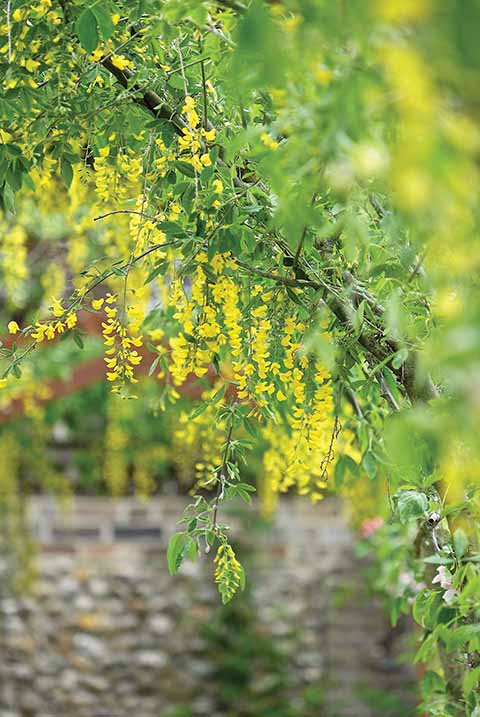Garden design tricks
Pauline Caroline Jones shares a few of the ‘tricks of the trade’ used by designers to enhance the garden experience
Published in January ’20

A quintessential formal garden with a central fountain, matching geometrically shaped borders and layered hedges at Parnham House
It’s NEW YEAR and time to don hat, scarf and wellies as, with notebook in hand, we begin by looking at the garden as a whole.
Garden design is all about organising and shaping outside space, bearing in mind that it needs to be practical and functional as well as aesthetic. Winter is a good time to review the framework of the garden, whether it be soft landscaping in the form of hedges, trees and evergreen shrubs or hard landscaping elements such as paths, water features and pergolas. This is what essentially forms the backbone of the garden and ensures all-year interest, allowing the imagination to run wild during those crazy, hazy days of our English summer.
It is fair to say that gardeners tend to be a little sceptical about the word ‘principle’ within the context of garden design, even though the gardens we visit and enjoy the most are likely to have those very principles in place.
Unity is one that can be most easily achieved through the repetition of colour, shape, texture and form. As an example, from a planting perspective, Geranium Heuchera and Astrantia share a similar leaf shape, so when planted together create a visual link. The same applies to the attractively layered shrub, Viburnum plicatum ‘Mariesii’, when repeated in another part of the garden in the form of the aptly named wedding cake tree, Cornus controversa ‘Variegata’.
Focal points are very effective, providing a place for the eye to settle while also allowing for movement around the garden. This often begins at the house, which perhaps takes in the view of a sculpture and from there leads the viewer to an ornamental seat under a particularly striking tree and so on. The beauty is that focal points can be temporary, filling a void between seasons; flower-pots of colourful bulbs and ephemeral annuals come to mind.
Borrowed views can be used effectively to disguise boundaries and bring the landscape into the garden, giving a semblance of openness. So if you are fortunate enough to have a gorgeous country or seaside view, or one of a neighbour’s stunning cherry tree, there is the perfect opportunity to invite it into your garden and link it with other features – another stunning cherry tree, perhaps.
During the English Landscape movement, the ha-ha (basically a ditch below a retaining wall) was invented by English landscape designer, Charles Bridgeman, to keep grazing stock out of the formal part of the garden while ‘calling in the country’, so to speak. Examples of this pastoral simplicity still exist at Kingston Lacy, Mapperton Gardens and the Old Rectory in Pulham.
Another historical influence that particularly appealed to the ancient Greeks is the trompe l’oeil: the painting of a flat surface so that it appears three-dimensional, deceiving the eye by giving the illusion of reality. When executed properly, these tricks can provide a theatrical atmosphere that may amuse, perplex or unsettle the viewer but at the same time be a wonderful source of escapism. The clever positioning of mirrors gives the impression of extending to another part of the garden, while the reflection of an expanse of sky in water accentuates a sense of space. Accomplished artist Gertrude Jekyll famously exploited plant colour to influence perspective, using warm colours at the front of a border, slowly fading to cool blues in the distance so that the border appeared longer.
Planting reinforces the design, softening and enhancing hard landscape elements while adding interest throughout the year. Winter and spring reveal the structure, and seasonality can be extended at this time of the year by underplanting perennials with early bulbs such as daffodils, spring snowflakes and tulips. The English flowering season tends to peak in late May, June and early July, then in high summer flowers take centre stage in all their glory. Autumn is all about architectural seed-heads and a tapestry of wonderfully rich leaf colour, while in the winter months the beautiful simplicity of bark and berries come into their own and nature takes over.
Often referred to as the New Perennial Movement, a naturalistic prairie style of planting continues to be a huge source of inspiration to gardeners, supporting wildlife and encouraging biodiversity, sustainability and ecological compatibility. Dutch garden designer and plantsman Piet Oudolf has pioneered this new approach to gardening by implementing a sophisticated palette of quite delicious herbaceous perennials and grasses, planted in bold drifts. Knoll Gardens has adopted many of these principles and used them to great effect.
When selecting plants, it is a good idea to choose a colour theme from the outset, then try to balance and repeat colours throughout the garden. If you are using a single colour scheme, try to add different foliage shades and textures for interest.
So now, with a notebook full of tips, hopefully you will be looking at your garden in a different light. It’s time to come in from the cold, sit yourself next to a roaring log fire with a steaming mug of hot chocolate and get excited about planning your garden, as we gardeners do at this time of the year.
GARDENS to visit
Parnham House sadly is no longer open to the public due to extensive fire damage.
The Old Rectory in Pulham is open through the NGS and for private tours.
Forde Abbey and Knoll Gardens are open throughout the year.
Athelhampton House and gardens was sold in July 2019 but remains open to the public under new ownership. Mapperton reopens to the public in March.




